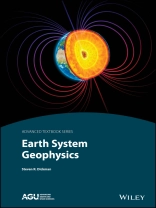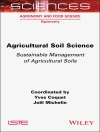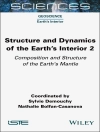Earth System Geophysics
Geophysics helps us understand how our planet works by connecting complex real-world phenomena with fundamental physical laws. It provides the tools, both conceptual and quantitative, for understanding interactions between the different components of the Earth System: the solid earth, oceans, atmosphere, and biosphere.
Earth System Geophysics is a comprehensive textbook for upper-level undergraduate and graduate students in the Earth sciences that uses Earth System Science as the framework for learning about geophysics.
About this volume:
- Presents convection as the underlying paradigm that drives the Earth System
- Uses math and physics in an accessible way to understand processes on and within the Earth
- Frames natural processes and events in terms of cause and effect
- Builds gradually from basic to advanced concepts and equations
- Develops quantitative skills through applied examples
- Heavily referenced, allowing students to pursue topics in greater depth
- Relevant for students from across the physical sciences and engineering
The American Geophysical Union promotes discovery in Earth and space science for the benefit of humanity. Its publications disseminate scientific knowledge and provide resources for researchers, students, and professionals.
Tabela de Conteúdo
Preface xvii
Acknowledgments xvii
About the Companion Website xix
Part I An Earth System Science Framework
1 The Birth of the Earth 3
1.0 Motivation 3
1.1 The Formation of the Solar System 3
1.1.1 Overview: Contrasting Theories Versus Solar System Basics 3
1.1.2 A Monistic Description of Solar System Formation 7
1.2 Properties of the Solar System 37
1.2.1 The Spacing of the Planetary Orbits 37
1.2.2 Moment of Inertia: A Diagnostic Tool for Planetary Interiors 42
1.2.3 A Brief Description of the Properties of Planets and Moons 45
1.3 Life in the Solar System, and Beyond 49
1.3.1 The Search for Planets 49
1.3.2 Evidence for Life in the Universe 54
1.3.3 Evidence for Life in Our Solar System 57
2 The Evolution of Earth’s Atmosphere 71
2.0 Motivation 71
2.1 The Differentiation of the Earth 72
2.1.1 A Core by Condensation? 72
2.1.2 An Act of Differentiation Created the Core 74
2.1.3 Consequences of Core Formation 75
2.2 The Faint Young Sun 86
2.2.1 The Young Sun’s Changing Luminosity Was Inevitable 87
2.2.2 A Paradox, and Its Resolution 88
2.2.3 The Urey Cycle 90
2.3 Constraints on the Evolution of Atmospheric CO 2 94
2.3.1 Levels of CO 2 Were (Relatively) Low During Ice House Climates 94
2.3.2 Other Approaches, and a Synthesis 97
2.4 The Development of an Oxygen Atmosphere 99
2.4.1 A Mostly Geology-Based Chronology of the Rise of Oxygen on Earth 100
2.4.2 Oxygen and Evolution: An Overview 112
2.4.3 Oxygen Chronology: A Synthesis 116
3 The Climate System and the Future of Earth’s Atmosphere 119
3.0 Motivation 119
The Climate System 120
3.1 The Circulation of the Atmosphere 120
3.1.1 The Sun Is the Ultimate Driving Force 120
3.1.2 Basic Concepts Underlying Atmospheric Circulation 122
3.1.3 Global Atmospheric Circulation on a Nonrotating Earth 123
3.1.4 Global Atmospheric Circulation on the Rotating Earth 124
3.1.5 Complications of the Three-Cell Model 125
3.1.6 Implications of the Three-Cell Model for Climate and Regional Circulation 128
3.1.7 A Brief Jovian Perspective 131
3.1.8 Jet Streams in the Atmosphere 133
3.1.9 Hurricanes 136
3.2 The Circulation of the Oceans 136
3.2.1 Thermohaline Convection 137
3.2.2 Wind-Driven Circulation 143
3.2.3 The Wind-Driven Oceans Move Heat, Too 147
3.3 El Niño and the Southern Oscillation: A Coupled Atmosphere—Ocean Phenomenon 150
3.3.1 El Niño 150
3.3.2 Southern Oscillation 151
3.3.3 The Mechanism of a Strong ENSO Event 155
3.3.4 The Mechanism of a Weak ENSO Event 158
3.3.5 The Return to Normalcy 159
3.3.6 There’s an Even Bigger Picture 160
The Immediate Future of Our Atmosphere 163
3.4 Preliminary Comments 163
3.5 Solar Variability on Human Timescales 163
3.5.1 Sunspot Cycles 163
3.5.2 A Connection Between Sunspots and a Dramatic Change in Earth’s Climate? 165
3.5.3 A Few Final Comments on Sunspots 169
3.6 Anthropogenic Variations in Climate by the Emission of Greenhouse Gases 169
3.6.1 Increases in Greenhouse Gas Abundances 170
3.6.2 Direct and Indirect Impacts on Climate Expected From an Increase in Greenhouse Gas Abundances 173
3.6.3 Tempered Expectations: Complications in How These Consequences Play Out 185
3.6.4 Anthropogenic Variations in Climate: Evidence Concerning Direct Consequences (—If You Insist) 193
3.6.5 Anthropogenic Variations in Climate: Evidence Concerning Indirect Consequences 201
3.6.6 Anthropogenic Climate Change: Some Final Thoughts 222
A Geophysical Perspective: The Rest of This Textbook 223
Part II a Planet Driven by Convection
4 Basics of Gravity and the Shape of the Earth 227
4.0 Motivation 227
4.1 The Nature of Gravity 228
4.1.1 Simple Expressions of the Law of Gravitation 228
4.2 Newton’s Second Law and the Gravity Field 235
4.2.1 Cause and Effect, Mass and Weight 235
4.2.2 Earth’s Gravity Field, and the Answer to a Really Fundamental Question 236
4.2.3 Weighing the Earth 239
4.3 The Gravity Field of a Three-Dimensional Earth 242
4.3.1 A Guiding Principle 242
4.3.2 More Consequences of Gravity Being an Inverse-Square Law Force 243
4.3.3 Revisiting Newton’s Law of Gravitation, With Superposition 246
4.4 The Shape of the Earth, and Variations of Gravity With Latitude 248
4.4.1 A Motivation to Get Complicated 248
4.4.2 The Earth Is Not Spherical 248
4.4.3 Earth’s Rotation Is the Cause 249
4.4.4 A Thorough Description of Centrifugal Force 252
4.4.5 Gravity Versus Centrifugal Force on a Rotating Earth 258
4.4.6 Indirect Effects of Centrifugal Force on Gravity, and the Idealized Earth 261
4.5 Kepler’s Laws 265
5 Gravity and Isostasy in the Earth System 269
5.0 Motivation 269
5.1 Exploring the Earth System with Gravity 269
5.1.1 Scaling Down for Gravity Exploration 269
5.1.2 The Reduction of Gravity Data 274
5.1.3 An Application to the Earth System 281
5.1.4 Gravity Data Measured on a Moving Platform 285
5.2 Isostasy and the Earth System 287
5.2.1 Bouguer’s Discovery and the Principle of Isostasy 287
5.2.2 Mechanisms to Achieve Isostatic Balance 289
5.2.3 The Moho and Other Evidence of Airy Isostasy 293
5.2.4 Airy Isostasy and the Oceanic Response to Atmospheric Pressure Fluctuations 294
5.2.5 A Third Mechanism for Achieving Isostatic Compensation 296
5.2.6 Isostatic Response to Surface Loads in the Earth System: Anomalous Regions 300
5.2.7 Isostatic Response to Surface Loads: Implications for Mantle Rheology 313
5.2.8 Global Constraints on Mantle Viscosity 319
6 Orbital Perspectives on Gravity 329
6.0 Motivation 329
6.1 Tides 329
6.1.1 Ebbs and Flows 329
6.1.2 Tidal Forces 330
6.1.3 The Response of the Oceans to Tidal Forces 332
6.1.4 The Response of the Solid Earth to Tidal Forces 335
6.2 Precession of the Equinoxes and Orbital Effects on Climate 338
6.2.1 Precession 338
6.2.2 Precession, the Core, and the Geomagnetic Field of the Earth 344
6.2.3 Precession Can Affect the Earth’s Climate 345
6.2.4 Milankovitch and Mars 357
6.3 Satellite Geodesy 359
6.3.1 Satellite Orbital Precession 359
6.3.2 The Geoid and Satellite Altimetry 368
6.3.3 Geoid Versus Spheroid, and Geoidal Heights 379
6.3.4 More Perspectives on Global Gravity and the Global Geoid 383
6.4 Tidal Friction 394
6.4.1 Another Way of Looking at Tides 394
6.4.2 The Solid Earth Will End Up in the Middle of It All, and Suffer Greatly 396
6.4.3 Tidal Friction Also Affects the Moon’s Orbit 399
6.4.4 Tidal Friction Has Consequences for the Earth System 401
6.4.5 Tidal Friction Without Oceans, and Astronomical Implications 403
6.4.6 Theories of the Origin of the Moon 405
7 Basics of Seismology 409
7.0 Motivation 409
7.1 Stress and Strain 409
7.1.1 Stress 410
7.1.2 Stress: A Rigorous Description 412
7.1.3 Strain 414
7.1.4 Strain: A Rigorous Description 417
7.2 Relations Between Stress and Strain in Elastic and Nonelastic Materials 419
7.2.1 Ideal Models of Different Materials 420
7.2.2 Material Properties of an Elastic Medium: Elastic Parameters 427
7.3 Elastic Waves 431
7.3.1 Descriptions of Waves 432
7.3.2 Elastic Waves: The Wave Equation 433
7.3.3 Elastic Waves: Reflection and Refraction 437
7.4 Surface Waves and Free Oscillations 452
7.4.1 Surface Waves 452
7.4.2 Free Oscillations 457
7.5 Seismic Waves and Exploration of the Shallow Earth 475
7.5.1 Refraction Surveys; or, First Arrivals on a Flat Earth 475
7.5.2 Refraction Surveys: An Illustration With Possible Hydrogeological Implications 478
7.5.3 Refraction Surveys: Thoughts About Multilayered Situations 481
7.6 Seismic Waves and Exploration of the Whole Earth: Preliminaries 482
7.6.1 Travel Times: Lateral Homogeneity Within the Earth 482
7.6.2 Travel Times: Locating Earthquakes 484
7.6.3 Travel Times: Identifying Phases on a Seismogram 489
8 Seismology and the Interior of the Earth 491
8.0 Motivation 491
8.1 Seismology and the Dynamic Earth 492
8.1.1 Defining Plate Tectonics 492
8.1.2 Quantifying Plate Motions 495
8.1.3 Plate Motions Through the Ages 498
8.1.4 A Last Look at Plates and Plate Motions 505
8.1.5 Travel Times and the Interior of the Earth 510
8.2 Seismology and the Large-Scale Structure of the Earth 514
8.2.1 Travel Times: The Shadow Zone and the Core 514
8.2.2 Travel Times: Determining Seismic Velocities Within the Earth 516
8.3 Seismic Velocities and the State of Earth’s Interior 521
8.3.1 Birch’s Rule 522
8.3.2 The Adams-Williamson Equations 532
8.3.3 Seismic Tomography 554
8.4 Using Earth Models to Learn About the Composition of the Interior 564
8.4.1 Equations of State 564
8.4.2 High-Pressure Experiments 568
9 Heat From Earth’s Interior 597
9.0 Motivation 597
9.1 Measuring Heat Flow 598
9.1.1 Basic Ideas and Practical Challenges 598
9.1.2 Heat Flow Data 600
9.1.3 Strengthening Our Theoretical Foundation of Heat Flow: An Introduction to Del 606
9.2 Heat Sources 607
9.2.1 Radioactivity 607
9.2.2 Gravitational Energy, Part One 609
9.2.3 Heat of Compression 609
9.2.4 Gravitational Energy, Part Two 613
9.2.5 Moon-Forming Impact 613
9.2.6 Tidal Friction 614
9.2.7 Another Look at Radioactivity 614
9.2.8 Growth of the Inner Core 618
9.2.9 Some Reflections, and What Must Come Next 619
9.3 Transmission of Heat in Solids 621
9.3.1 Conduction Plus Conservation Equals Diffusion 621
9.3.2 The Nature of Diffusion 624
9.3.3 Some Solutions to the Diffusion Equation 627
9.3.4 Learning From Failure: A Deeper Look Into Heat Flow by Conduction 630
9.4 Transmission of Heat in Fluids 638
9.4.1 Fluid Stability 639
9.4.2 How Convection Works in a Fluid 640
9.4.3 Heat Transmission in a Convecting Fluid 649
9.4.4 Horizontal Convection 652
9.4.5 Temperatures Within a Convecting Fluid; Fluid Versus Solid-State Convection 658
9.5 More on Surface Heat Flow in the Earth System 666
9.5.1 Geothermal Heat and the Thermohaline Circulation 667
9.5.2 Subsurface Temperature Variations and Climate Change 669
10 Geomagnetism and the Dynamics of the Core 677
10.0 Motivation 677
10.1 The Earth’s Magnetic Field 678
10.1.1 Dipole Fields 678
10.1.2 An ‘Elemental’ Description of Magnetic Fields, with Reference to the Earth 680
10.1.3 Magnetic Fields: An Overview of the Earth System 682
10.2 Global Descriptions of the Internal Field 707
10.2.1 Satellite Missions Dedicated to Observing Earth’s Magnetic Fields 708
10.2.2 Spherical Harmonics, Once Again 711
10.2.3 Back to the Surface: A Closer Look at the Crustal (and Geomagnetic) Fields 718
10.3 Snapshots in Time of the Geomagnetic Field 726
10.3.1 Current and Recent Snapshots 726
10.3.2 Snapshots Further Back in Time 743
10.4 Generation of the Geomagnetic Field 755
10.4.1 Preliminary Assessments 755
10.4.2 Fields Weaken, Fields Strengthen 758
10.4.3 Examples of Simple Dynamos 765
10.4.4 Inescapable Wisdom From Unavoidable Equations 768
10.4.5 Dynamo Flow in a Taylor-Proudman World 776
10.4.6 Some Final Thoughts 788
References 791
Index 891
Sobre o autor
Steven R. Dickman, Binghamton University, USA












